15 Methods to Use When Tracking Marketing Campaigns

Tracking marketing campaign performance is integral to ensuring the success of a brand’s promotion efforts.
Knowing what tools to use and how to use the data correctly gets you better results, lets you meet your goals more effectively, and earn the trust of your clients and team.
This article covers everything you need to know about tracking a campaign’s performance. From the different tracking techniques and tools to the various KPIs to monitor, this post guides you to mastering marketing tracking.
Table of Contents
- What is the main purpose of tracking?
- 15 tools marketers use for tracking marketing campaigns
- 1. Dynamic QR code tracking
- 2. UTM tracking links
- 3. Social media monitoring
- 4. Conversion tracking pixels
- 5. Customer relationship management tracking
- 6. Ad network conversion tracking
- 7. Call tracking software
- 8. Email marketing tracking
- 9. KPI dashboard use
- 10. Behavior analytics
- 11. Google Analytics
- 12. Affiliate marketing tracking
- 13. Heatmaps
- 14. Session recordings
- 15. Customer feedback
- KPIs for marketing campaigns that every marketer should track
- The benefits of tracking ROI and other KPIs
- Keep track of your campaign’s performance with the best QR code generator
- FAQ
What is the main purpose of tracking?
The primary purpose of marketing tracking is to gather data that helps you understand behavior and measure campaign performance. The data-driven insights lets you find effective strategies, identify areas of improvement, and plan future campaigns.
Monitoring marketing campaigns commonly revolve around the user and the actions they take when encountering a brand’s content to the business’s revenue from sales. These actions help define the effectiveness of a brand’s efforts and the future of marketing campaigns.
15 tools marketers use for tracking marketing campaigns
It’s clear that tracking is an important aspect of marketing. With that in mind, let’s look into the different methods for tracking campaigns online.
1. Dynamic QR code tracking
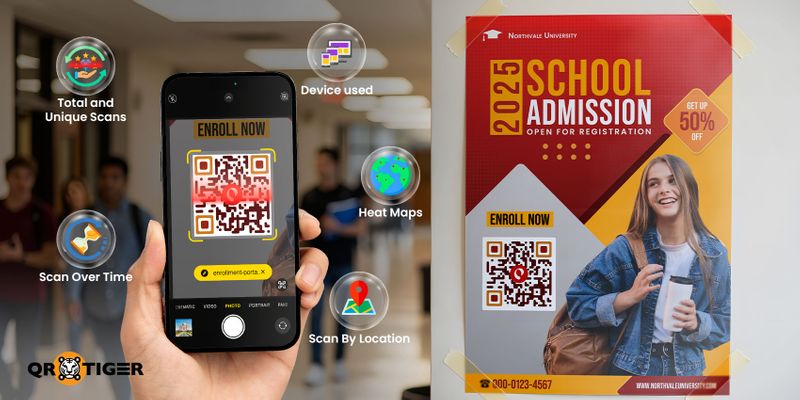
QR codes, the iconic black-and-white squares, are normally seen as storage for links. These are commonly static QR codes, the permanent type.
Dynamic QR codes are more advanced and flexible. It’s what most businesses and marketing teams use to effectively track their phygital marketing campaigns.
These codes embed a short, editable URL. Once the user scans the code, the request goes through the QR generator’s server before redirecting to the actual destination (e.g., website, PDF, or app).
This allows the dynamic QR code generator to track various metrics such as:
- scan numbers (total and unique)
- scan locations
- device used
- scans over time
- heat maps
It compiles these logs in the dashboard so businesses can quickly see and measure campaign performance, similar to how web analytics tools work.
Note that the data collected is about the scan, not the person. QR code tracking doesn’t personally identify users, it just gives marketers aggregate insights.
Learn more: QR Code Tracking with Dynamic QR Codes: How It Works
2. UTM tracking links
Another effective method of tracking campaigns is using UTM parameters in your URLs.
UTM tags, short for Urchin Tracking Module tags, are the bits of text you see at the end of the URL of some web pages.
Here’s an example:
Everything after the question mark (?) is a UTM tag.
Each tag is a key=value pair, which tells analytics tools like Google Analytics the context of the click. These allow you to see not just that a visit happened, but where it came from and why.
These are the five standard UTM parameters to add in a URL:
- utm_source - Where the traffic came from (e.g., facebook, qr-code, newsletter).
- utm_medium - The type of channel (e.g., social, email, cpc, print).
- utm_campaign - The campaign name (e.g., summer_sale, launch2025).
- utm_term - (Optional) For paid search keywords.
- utm_content - (Optional) To distinguish between different ads/links in the same campaign.
Tip: add UTM parameters to your URL QR code. This will give you end-to-end tracking: from the moment of scan to the final conversion.
Learn more: How to Track Your Campaign with UTM URL QR Code
3. Social media monitoring
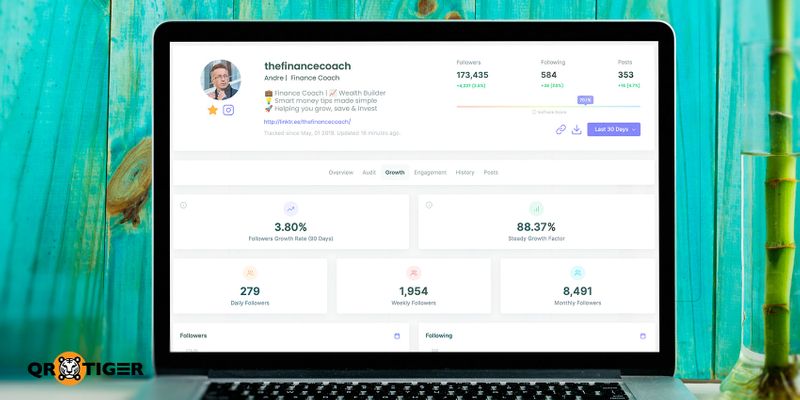
With 5.41 billion social media users worldwide, measuring a campaign’s performance through these platforms is practically essential.
Social media monitoring often involves a brand observing what users are saying about them on various platforms.
This can even be done without a specialized tool by simply checking for any mentions of your brand or use of your hashtags, but this obviously takes more time and effort.
Another component to this method is tracking engagement levels, the extent of a brand’s reach, and the number of conversions from social media platforms.
Facebook Insights, Instagram Analytics, and LinkedIn Analytics are built-in tools of the biggest platforms that help brands in this endeavor.
💡Pro Tip: A dynamic QR code for Instagram or other social media platforms comes with tracking and analytics. Use them to market your online presence while learning more about your user base!
4. Conversion tracking pixels
Conversion tracking pixels are bits of code embedded in the HTML of a webpage that send data to an ad platform or analytics software. This data holds information about user actions that take place while a webpage is being visited.
Actions that a pixel can track include:
- page views
- purchases
- form submissions
- registrations
Various tools exist to track the data gathered by conversion tracking pixels. Many come from the biggest platforms online like Facebook (Facebook Pixels), Google (Google Ads Pixel), and LinkedIn (LinkedIn Insight Tag).
These pixels are also useful to enable “retargeting” or remarketing campaigns, intended for businesses (B2B) or customers (B2C) who have already shown interest in your product or service and are yet to take action.
Quick Resources:
>> QR Code Retargeting: Generate Leads and Boost Conversions
>> QR Code for Facebook Pixel Retargeting Tool: Tailor and Track Your Ads
5. Customer relationship management tracking
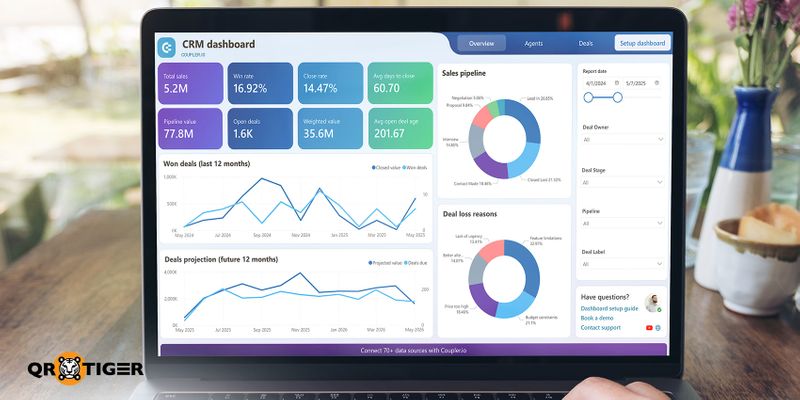
Customer relationship management (CRM) refers to systems that allow businesses to manage interactions with customers. This can help increase customer satisfaction and retention, but it can also help track the performance of marketing campaigns.
Part of managing relationships with customers through a CRM is storing data, tracking communications, and compiling this information into reports.
Through these, brands can use a CRM as a marketing project tracker to get insight into customer needs and behavior, knowledge that can give insight into the performance of an ongoing campaign.
6. Ad network conversion tracking
Whenever a customer clicks on an advertisement and performs specific actions, it is known as a conversion. These actions often lead to acquiring leads or generating sales, meaning they can range from purchasing a product to downloading an app.
With that said, conversion tracking simply gathers information on conversions and identifies which channels or campaigns are bringing in positive results.
Advertisers set this up in their ad platform such as Google Ads, Meta Ads, or TikTok Ads. Ad network conversion tracking can either work in two methods:
- browser-side tracking using pixels, like the Facebook Pixel. This relies on cookies to tie the user’s ad click or view to their later actions, or
- server-to-server (S2S) tracking, which sends the conversion data directly from the advertiser’s server to the ad network’s server. This is often implemented through Conversions API.
Once conversions are tracked, you will see reports on which campaigns, ads, or keywords drove results.
7. Call tracking software
Call tracking software is an application that allows brands to gather data from phone calls with customers. This helps marketers find out which campaign drove the customer to make the call and determine what the result of the call was.
Something that is important to understand is how this software works. Calls to phone numbers are often done offline, so how can such specific information be tracked?
The answer lies in the phone number being called. When using call tracking software, a unique tracking number is assigned to a campaign. This number is then placed on a brand’s websites or promotions.
When a user dials the tracking number, they are redirected to the business’s regular phone number. This is then tracked, monitored, and analyzed by call tracking software.
8. Email marketing tracking
Similar to call tracking, email tracking involves monitoring the actions taken by recipients after getting a brand’s emails like opening, clicking, forwarding, or making a purchase afterward.
It’s widely used in marketing, sales outreach, and newsletters.
Depending on the platform you’re using and its privacy settings, you may see:
- Open rate (who opened and when)
- Click-through rate (which links were clicked)
- Device and email client (desktop vs. mobile, Outlook vs. Gmail, etc.)
- Geolocation (approximate, from IP address)
- Conversions (if connected with analytics or e-commerce systems)
9. KPI dashboard use
Tracking campaign performance involves analyzing various key performance indicators (KPI) from various channels. To handle the large amounts of information that can come from your campaign, a KPI dashboard will be needed.
A KPI dashboard is a tool that gathers and analyzes data from multiple marketing channels. This data can then be presented visually through charts and graphs, which helps businesses determine the best course of action to take when it comes to their campaigns.
💡Did you know: The QR code tracking and analytics feature from our QR code generator with logo integration comes with a dashboard for better data visualization. See how well your QR codes perform!
10. Behavior analytics
Behavior analytics is another method marketers use to measure and track the performance of their campaigns.
Similar to other methods in this list, behavior analytics is used to study user interactions with marketing content.
The difference, however, is that it includes more actions especially when actions in an app are being studied.
Examples of relevant actions include:
- account registrations
- form submissions
- purchasing an item or subscription
- abandoning a cart
- clicks and scrolls through the app
- duration and frequency of app usage
Some of the best tools to use to start tracking user behaviors are Hotjar, good for seeing how users interact with pages and identifying UX issues, and Mixpanel, which is great for tracking user journeys over time.
11. Google Analytics
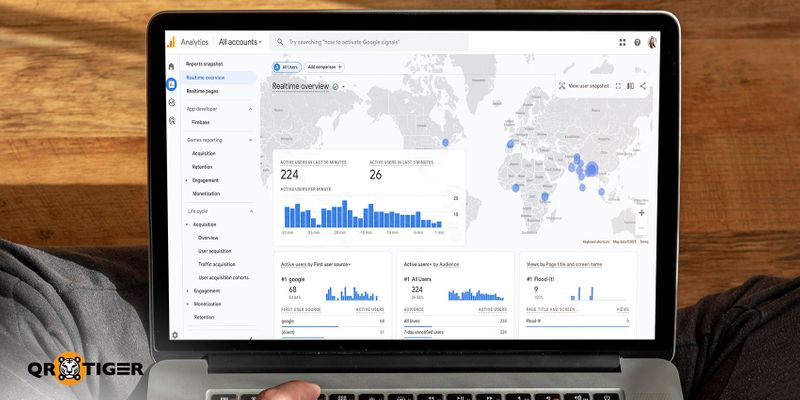
Google Analytics is a service created by Google, one of the largest tech companies in the world. As part of the Google Marketing Platform, it provides several digital marketing tracking tools for monitoring website performance and getting insight into visitors.
With this service, marketers can find the origin of website traffic, web pages that are interacted with, actions taken by visitors, and other demographical data.
If you’re using UTM tags and website pixels for tracking on your website, email, or QR code campaigns, Google Analytics is an effective tool to track and measure a marketing campaign’s success across different channels.
The latest version, Google Analytics 4 (GA4), now includes machine learning predictions. It is also event-based and doesn’t rely as heavily on cookies. It’s best to use for cross-platform tracking.
Learn more: How to Track QR Codes with Google Analytics
12. Affiliate marketing tracking
Influencer marketing is a strategy that involves collaborating with highly influential people to promote a brand. Thanks to social media, this form of marketing has become very popular, which makes tracking influencer marketing performance all the more important.
One of the ways influencer marketing campaigns are monitored is through the use of unique tracking links known as affiliate codes. These links are given to influencers, who then share it with their audience.
With the help of affiliate tracking software, brands can check in on influencer campaigns by following a customer’s journey from clicking an affiliate link to completing a desired action, and measure the return-on-investment.
13. Heatmaps
Another method of tracking the effectiveness and performance of a marketing campaign is through the use of heatmaps.
When it comes to campaign tracking, heatmaps show marketers a visual representation of a user’s interactions while visiting a website.
Just like other applications of a heatmap, areas with heavy interaction appear in warmer colors, while those with few interactions appear colder.
14. Session recordings
While Heatmaps show a snapshot of a user’s visit, session recordings record a user’s entire session. This can give marketers raw evidence of the effectiveness of their digital campaigns.
Heatmap and session recording features often come in software like Hotjar or Crazy Egg. Together, marketers can see how effective their landing pages and websites are, which can help improve any ongoing campaign.
15. Customer feedback
Learning about how well your campaign is going can always come straight from the customers you are targeting. Because of this, looking through customer feedback might be the most beginner friendly method on this list, but by no means does this make it the least effective.
⭐ Pro tip: A form builder is a tool that can not only make form generation a breeze, but it also makes distributing forms far easier than through print.
KPIs for marketing campaigns that every marketer should track
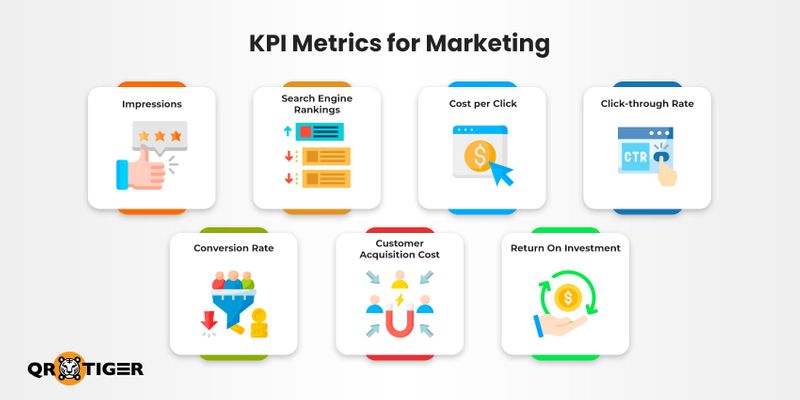
The techniques and tools the marketing industry have come up with over the decades is truly astonishing to think about. However, just as important are the different metrics that can be derived from tracking .
Impressions
This KPI refers to the number of times marketing content appears on screens, whether it is interacted with or not. This basically describes how visible promotions are, with a high number of impressions being an indication of high visibility.
Having visible content increases brand awareness and is a contributing factor in expanding reach.
Search engine rankings
When looking for anything on search engines like Google or Bing, what you see on the first page of the Search Engine Results Page (SERP) depends on the engine’s selection algorithm.
Regardless of which engine a user uses, being on top of the results page is always a net positive for a brand, which is what makes this one of many KPIs for marketing teams.
Cost per click
This KPI is an indicator of how much you have to pay every time a user clicks on your ad, something that is more common in the pay-per-click model of advertising.
To calculate a campaign’s cost per click (CPC), the total cost of the ad should be divided by the number of clicks it received. This means that a lower CPC tells a brand that its campaign has proven cost-effective.
Click-through rate
A KPI that tools like affiliate marketing tracking software can measure, click-through rate (CTR) refers to the percentage of people that clicked on an ad after seeing it. This measurement is calculated by dividing the number of clicks an ad or link gets by the total number of views (also known as impressions).
According to CXL, a CTR of 6.64% for search and 0.57% for display is considered the average across all industries. Determining what a good CTR for a campaign will depend on industry, the channels used, and ad position on the page, and even the ad format.
Conversion rate
Another KPI a marketing tracker must analyze is the conversion rate, which is the percentage of users who perform a desired action when visiting a website.
A high conversion rate means that a significant portion of users that visit a website complete actions that benefit a business, which is a sign of an effective marketing campaign.
Customer acquisition cost
Customer acquisition cost (CAC) is a KPI that tells marketers how much money is spent acquiring new customers through their campaign.
It is calculated by dividing all marketing and sale expenses over a specific period of time by the number of new customers acquired in that time. This is particularly helpful when using the influencer tracking method of monitoring marketing campaigns where a brand pays influencers to promote their content.
Return on investment
Famously known as ROI, this KPI refers to the amount of profit earned after subtracting marketing costs from the revenue generated.
A marketing campaign with a high ROI is a sign that the strategies and tactics employed by a brand were successful, making them viable options in future campaigns.
The benefits of tracking ROI and other KPIs
Every KPI mentioned can impact the decision making of any brand, but there are other benefits to them that don’t involve knowing if a campaign was successful.
Increased customer satisfaction
Tracking a campaign’s progress and its performance allows brands to see what content users respond to. Learning what these are can help businesses give their audience exactly what they want, which will lead to more satisfied customers.
Optimized marketing campaigns
There are plenty of strategies, channels, and content types marketers can use for their campaign. However, teams can be limited by their budget, deadlines, or even their goals, so knowing exactly what should be a part of a planned campaign is important.
The knowledge of what can work for the goals set can come from the past and even the current campaign, which is why tracking ROI and other KPIs is essential.
Improved communication between teams
KPIs help inform a business of what should be done to achieve their goals. With metrics that indicate how visible or costly their ads are, marketing teams can provide clearer information that can help the entire brand make more strategic business decisions.
Keep track of your campaign’s performance with the best QR code generator
With more than a dozen ways to monitor a campaign’s progress and success, being a marketer must be overwhelming.
However, you shouldn’t be intimidated by the number of options for tracking marketing. The key to choosing the right methods depends on the goal of your campaign.
To take your marketing and tracking to the next level, we recommend the use of QR codes. Not just any QR codes, but dynamic codes.
With several dynamic QR code solutions and the tracking and analytics to back them up, you can’t go wrong by using this software.
Try out our freemium plan to generate up to three dynamic QR codes for free. 
FAQ
What is tracking in marketing?
When tracking is used in marketing, it involves the monitoring and analysis of user actions during an ongoing campaign. It is used to understand customer preferences, effective strategies, and options for future promotions.
What is call tracking marketing?
Call tracking is a technique in which a business assigns a unique phone number to specific content. When dialed, the phone number redirects the caller to its official business number, allowing the company to track which campaigns, keywords, or advertisements drive phone calls.
Which tool is commonly used for tracking marketing performance?
The most used tool to track marketing performance is Google Analytics 4 (GA4). 


